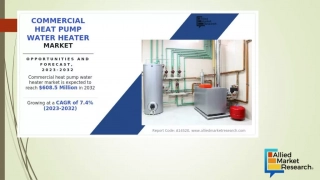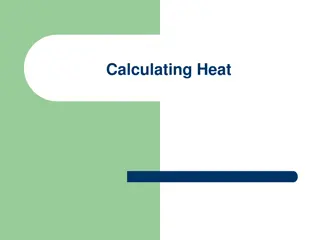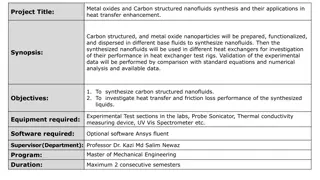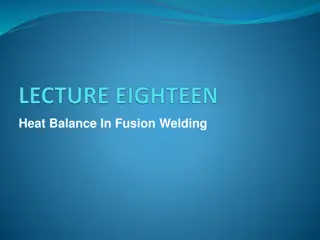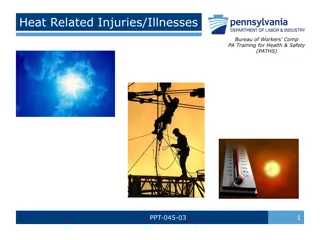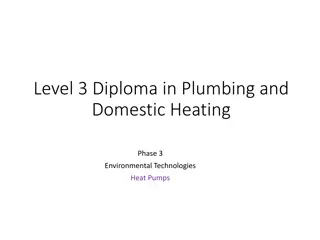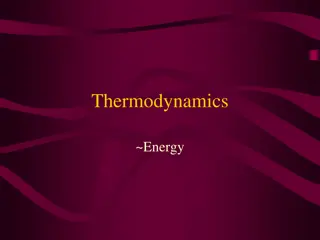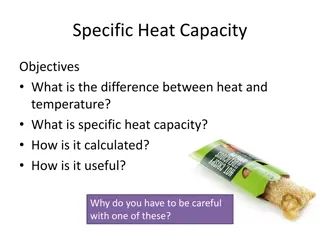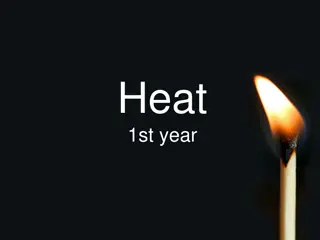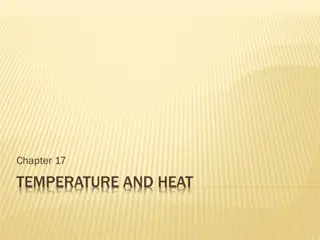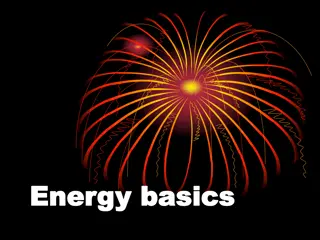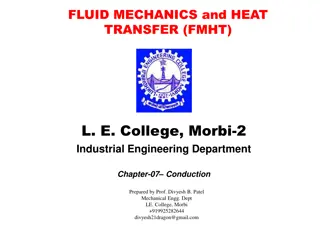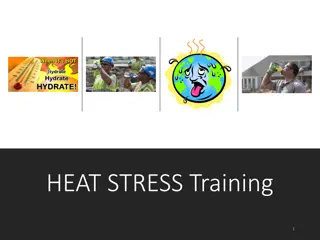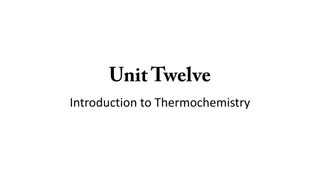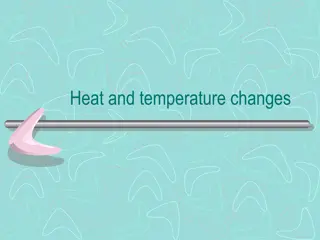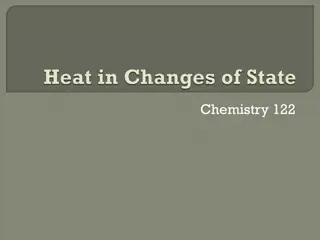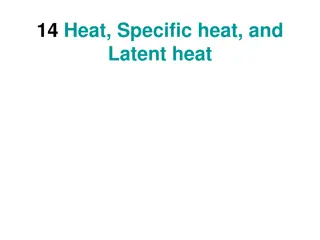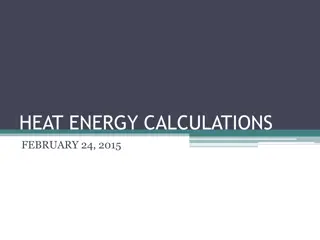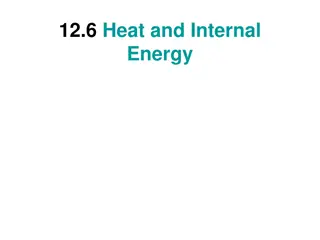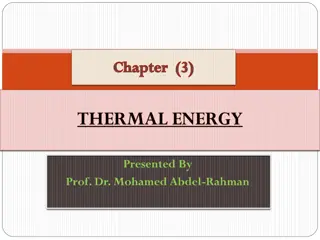Green Energy Market
Green energy also referred to as clean energy, is usually derived from natural sources that are constantly replenished. Solar energy, wind energy, hydroelectric power, biomass energy, geothermal energy, tidal energy, and wave energy are different types of renewable energy. Solar energy is the radian
6 views • 6 slides
commercial heat pump water heater market
Heat pump water heaters are used to move heat from the source to a sink, by utilizing electricity instead of generating heat directly. Heat pumps are used to facilitate the movement of thermal energy by absorbing heat from a cold space and release it. Further, several commercial businesses such as h
2 views • 6 slides
Applications of Heat Exchangers in Various Industries
This topic delves into the diverse applications of heat exchangers in different industries and plants, elucidating the use of various types of heat exchange systems and their importance in processes like bio-processing, power generation, and more. The lecture covers heat exchange applications for li
0 views • 24 slides
Energy and Heat Transfer Problems Explained
Solve various physics problems related to heat transfer, specific heat, latent heat, and efficiency in heating devices. Calculate the amount of heat needed to raise the temperature of different substances, melt solids, and evaporate water. Explore concepts like specific heat, latent heat of fusion,
2 views • 25 slides
Improving Heat Rate Efficiency at Illinois Coal-Fired Power Plants
Heat rate improvements at coal-fired power plants in Illinois are crucial for enhancing energy conversion efficiency, reducing carbon intensity, and minimizing pollution. By increasing the heat rate/efficiency by 6%, these plants can generate more electricity while burning the same amount of coal. T
2 views • 11 slides
Insights on Outdoor Heat Exposure: OSHA Data Collection Pilot 2022
The Occupational Safety and Health Administration (OSHA) conducted a Data Collection Pilot from June to September 2022 to quantify outdoor heat exposure and assess employer heat illness prevention programs. Key findings include identifying elements of successful prevention programs, comparing workpl
0 views • 22 slides
Heat Injury Prevention and Hydration Tips for Safety at Work
Discussing the importance of heat injury prevention, this content provides valuable guidelines on recognizing heat-related issues, staying hydrated, and maintaining a safe environment in challenging weather conditions. Tips include monitoring the heat index, using heat stress thermometers, providing
1 views • 7 slides
Understanding Heat and Energy Changes in Chemistry
Explore the concepts of heat, specific heat, phase change, and energy calculations in chemistry. Learn how to calculate heat, specific heat values for different substances, and the energy needed for phase changes like vaporization and fusion. Practice problems and examples are provided to enhance un
0 views • 12 slides
Occupational Heat Exposure Control and Prevention Practices
Occupational Heat Exposure Control and Prevention Practices at the New Mexico Institute of Mining and Technology covers training for workers exposed to excessive heat, pre-test evaluation, objectives focusing on heat stress and exposure, understanding heat and heat stress, human body's response to h
1 views • 37 slides
Understanding Heat, Temperature, and Energy Transfer
Delve into the concepts of heat and temperature, exploring their relationship and implications in energy transfer. Discover the significance of heat capacity, specific heat capacity, and how mass influences the heating and cooling rate of substances. Learn how to calculate heat using specific heat c
3 views • 12 slides
Advanced Research in Nanofluids and Heat Transfer Enhancement
This project focuses on synthesizing carbon structured and metal oxide nanoparticles to create nanofluids for use in heat exchangers. The research includes investigating heat transfer performance, friction loss, and drag reduction of the synthesized fluids. Additional studies involve exploring novel
0 views • 5 slides
Understanding Heat Balance in Fusion Welding
In fusion welding, the heat balance is crucial for melting the metal efficiently. Factors like heat transfer, melting point, and energy conversion affect the amount of heat available for welding. The combination of heat transfer and melting factors reduces the net heat available for welding, impacti
0 views • 12 slides
Understanding Heat and Temperature in Thermodynamics
Thermal energy transfer, heat, and temperature play crucial roles in determining the behavior of systems in terms of kinetic energy and molecular motion. The zeroth law of thermodynamics establishes the relationship between heat and temperature. Heat transfer leads to changes in the average kinetic
8 views • 8 slides
Extreme Heat Preparedness and Impacts: CERT Hazard Annexes
Introduction to CERT Hazard Annexes focusing on extreme heat, discussing heat-related illnesses, impacts of extreme heat, and preparedness measures including insulation, window protection, and attic fans. The content emphasizes the preventable nature of heat-related illnesses and the vulnerabilities
0 views • 26 slides
Understanding Heat-Related Injuries and Illnesses in the Workplace
Learn about different types of heat injuries/illnesses, prevention tips, statistics, and who is affected by heat-related issues. Discover how heat stress occurs, the body's cooling system, and the dangers of heat stroke. This comprehensive guide will help you understand how to work safely in the sun
3 views • 46 slides
Understanding Heat Pumps and Their Efficiency
Heat pumps are essential in modern environmental technologies, transferring heat from one area to another efficiently. They work on a refrigeration cycle principle, converting low-temperature heat to higher temperatures. The heat pump system's efficiency is measured by the Coefficient of Performance
0 views • 124 slides
Understanding Heat Transfer in Science
Investigate and understand the movement of heat between objects through conduction, convection, and radiation. Learn to compare materials that conduct heat with insulating materials, describe heat transfer processes, and design experiments to study heat energy movement. Explore the use of ratio reas
0 views • 31 slides
Understanding Thermodynamics: Energy and Heat
Explore the fundamental concepts of thermodynamics, including the conservation of energy, entropy, heat transfer, and the relationship between temperature and kinetic energy. Discover how energy transforms in natural events, the laws governing thermodynamics, and the role of heat in the motion of pa
0 views • 28 slides
Understanding Heat Transfer Mechanisms
Heat transfer is a fundamental concept in physics, involving the movement of thermal energy between objects. This interactive content explores different types of heat transfer such as conduction, convection, and radiation. It discusses how heat is measured, the properties of various materials in con
0 views • 4 slides
Understanding Enthalpy and Heat Capacity in Chemistry
Enthalpy is a measure of total energy in a system, represented as H = E + P.V. Heat at constant pressure relates to enthalpy changes. Calorimetry and heat capacity help measure and understand heat in chemical reactions. Specific heat capacity and molar heat capacity play key roles in determining ene
0 views • 16 slides
Understanding Heat-Related Illnesses in Sports Medicine
Hyperthermia is a condition where body temperature is elevated, posing risks like heat stress and heat-related illnesses. Proper knowledge of factors like temperature, humidity, and hydration is crucial for athletes and coaches to prevent such conditions during workouts. Metabolic heat production, c
1 views • 29 slides
Understanding Different Forms of Energy and Work in Physics
Energy in physics is the capacity to do work, and there are various forms of energy such as radiant energy, kinetic energy, gravitational potential energy, elastic potential energy, chemical potential energy, nuclear potential energy, electrical potential energy, thermal energy, and sound energy. Ea
0 views • 47 slides
Understanding Specific Heat Capacity and its Importance in Heat Transfer
Discover the key differences between heat and temperature, grasp the concept of specific heat capacity, how it is calculated, and its practical applications in energy transfer processes. Be cautious with hot objects like an apple pie to avoid burns. Explore how specific heat capacity influences the
0 views • 17 slides
Understanding Heat Energy and Transfer
Heat energy is a versatile form of energy that can be converted into other forms such as chemical or electrical energy. This article explains the basics of heat energy, its production, transfer mechanisms like conduction, convection, and radiation, and how it affects the expansion and contraction of
0 views • 41 slides
Understanding Heat Stress and Prevention Techniques
Heat stress can lead to various heat-related illnesses and affect concentration at work. It's essential to be hydrated, wear appropriate gear, and monitor symptoms to prevent heat-related issues. Factors like hydration levels, environmental conditions, and personal health play a crucial role in mana
0 views • 11 slides
Understanding Temperature, Heat, and Energy Transfer
Explore the concepts of temperature scales, absolute zero, heat transfer, units of heat, equivalence between heat and energy, specific heat capacity, and more. Learn about the relationship between heat, energy, and temperature in an engaging visual format.
0 views • 29 slides
Understanding Energy Basics: Temperature, Heat, and Transfer
Explore the fundamental concepts of energy, including temperature, heat, and energy transfer. Learn how temperature differs from heat, how they are measured, and the relationship between thermal energy and water volume. Discover the role of chemical energy and sound energy, and how energy is transfo
0 views • 12 slides
Understanding Heat Transfer: Conduction, Convection, and Radiation
Heat transfer is a fundamental process that occurs through conduction, convection, and radiation. Conduction involves the transfer of heat between particles through direct contact, while convection moves heat within fluids and gases through currents. Radiation is heat transfer through electromagneti
0 views • 13 slides
Heat Stress Training and Prevention Information
Learn about heat stress training, factors increasing the risk for heat-related illnesses, dehydration, early and later signs of heat-related illnesses, how to replace lost fluids, and how to manage heat cramps and exhaustion. Stay hydrated and recognize the signs to prevent heat-related issues in va
0 views • 20 slides
Understanding Sterilization Methods and Equipment for Pharmaceutical Products
Sterilization is crucial in the production of sterile pharmaceuticals, involving the removal or destruction of microorganisms to ensure product safety. Methods include physical (moist heat, dry heat, irradiation), chemical (gaseous, liquid sterilants), and non-thermal techniques like ethylene oxide
0 views • 35 slides
Workplace Heat Safety Tips and Warning Signs
Learn about workplace heat safety measures to prevent heat-related illnesses. Understand how the body regulates temperature, signs of heat stress, and steps to take in case of heat-related emergencies. Stay informed and prepared to ensure a safe working environment during heat waves.
0 views • 15 slides
Understanding Heat Exchangers in Food Operations and Equipment
Explore the world of heat exchangers used in food operations, including pasteurization, blanching, evaporation, drying, sterilization, freezing, and extrusion. Learn about different types of heat exchange equipment such as double tube heat exchangers, shell and tube heat exchangers, and plate heat e
0 views • 40 slides
Exploring Thermochemistry and Heat Energy Transfer
Thermochemistry involves the transfer of heat energy during chemical reactions and physical changes. Understanding concepts like enthalpy, heat capacity, and energy flow is crucial. The high heat capacity of water plays a vital role in moderating temperature changes in the environment. The law of co
0 views • 16 slides
Understanding Heat and Temperature Changes in Chemistry
Heat and temperature changes in chemistry are crucial concepts to comprehend. Heat capacity, molar heat capacity, and specific heat capacity play significant roles in determining temperature changes when heat energy is added or removed. Different substances have varying abilities to absorb heat, aff
0 views • 17 slides
Understanding Heat Transfer in Phase Changes of Water
Water molecules exhibit different behaviors in the liquid and gaseous states due to varying attractions between molecules. To change liquid water to a gas, energy must be added to overcome intermolecular forces, making this process endothermic. The heat absorbed during melting is equal to the heat r
0 views • 22 slides
Understanding Heat, Specific Heat, and Latent Heat
Heat is energy transferred between objects due to temperature difference. Specific heat capacity measures the amount of heat needed to change the temperature of a substance. Latent heat is the energy required for a phase change without a temperature change. Calorimetry and measuring specific heat ar
0 views • 14 slides
Understanding Heat Transfer: A Comprehensive Overview
Heat transfer is a fundamental concept in physics, where energy moves from hot to cold objects through conduction, radiation, and convection. Heat is not a substance but a form of energy that speeds up molecules. Conduction transfers heat between substances in direct contact, while convection involv
0 views • 13 slides
Understanding Heat Energy Calculations in Science
Explore concepts related to heat energy calculations in this science lesson, covering topics such as heat of fusion, average kinetic energy, specific heat capacity, and more. Dive into scenarios involving temperature changes, energy transfer, and equilibrium states of substances like water and ice.
0 views • 18 slides
Understanding Heat, Internal Energy, and Specific Heat Capacity
Heat is energy transfer due to temperature differences, measured in joules or calories. Internal energy includes kinetic and potential energies. Specific heat capacity is the heat needed to change temperature. Units like joules, calories, and BTUs are common. Calorimetry is used to measure heat chan
0 views • 13 slides
Understanding Thermal Energy Transfer and Heat Exchange
Exploring thermal energy in Chapter 3, we delve into concepts like heat, internal energy, specific heat, calorimetry, latent heat, phase change, energy transfer, and global warming. Discover how energy moves between objects of different temperatures and learn about the definitions and units of heat
0 views • 11 slides

